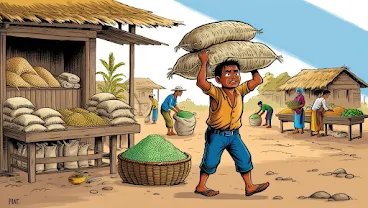In life, every transformation brings an increase in value, and the journey from milk to ghee is a perfect metaphor for this truth. Milk, the simplest form, costs 20 rupees. It’s wholesome and nourishing, but its potential doesn’t end there. When milk transforms into curd, its value rises to 30 rupees. The process of fermentation adds depth, flavor, and health benefits, making it more versatile. Next, curd can be churned into butter, a richer and more concentrated product, valued at 60 rupees. Butter is a symbol of refinement, offering a creamy texture and enhanced taste. But the journey doesn’t stop here. When butter is further clarified into ghee, its value soars to 200 rupees. Ghee is pure, golden, and packed with richness, representing the pinnacle of this transformation.
This progression teaches us an important lesson: with each change, with each step of effort and refinement, our knowledge and value increase. Just like milk evolves into ghee, we too can transform ourselves through learning, experience, and perseverance, becoming more valuable with every stage of our journey. Embrace change, for it is the path to growth and excellence.
The Science Behind the Transformation
The journey from milk to ghee is not just a culinary process; it’s a scientific marvel. Milk is a complex mixture of water, fats, proteins, and sugars. When it is fermented to make curd, bacteria like Lactobacillus convert lactose into lactic acid, giving curd its tangy flavor and probiotic benefits. This transformation increases its nutritional value and shelf life.
When curd is churned, the fat globules in the milk coalesce to form butter, separating from the buttermilk. Butter is rich in fat-soluble vitamins like A, D, E, and K, making it a concentrated source of energy and nutrients. Finally, when butter is heated to make ghee, the water evaporates, and the milk solids are removed, leaving behind pure, golden fat. Ghee is not only rich in flavor but also has a high smoke point, making it ideal for cooking. It is also lactose-free, making it suitable for those with dairy sensitivities.
Each step in this process requires time, effort, and knowledge. Similarly, in life, growth and transformation demand patience, dedication, and a willingness to learn.
The Cultural Significance of Milk and Its Byproducts
In many cultures, milk and its byproducts hold immense cultural and spiritual significance. In India, for example, milk is considered a symbol of purity and nourishment. It is offered to deities in temples and used in religious rituals. Curd, butter, and ghee also play important roles in traditional ceremonies and festivals.
Ghee, in particular, is revered in Ayurveda, the ancient Indian system of medicine. It is believed to balance the body’s doshas (energies), improve digestion, and promote mental clarity. The process of making ghee is often seen as a sacred act, symbolizing the purification of the mind and soul.
This cultural significance underscores the idea that value is not just monetary but also spiritual and emotional. Just as milk and its byproducts are cherished for their cultural and spiritual importance, our personal growth and transformation add value not only to ourselves but also to the communities we are part of.
The Economics of Value Addition
The journey from milk to ghee also illustrates the concept of value addition in economics. Milk, at 20 rupees, is a raw material. When it is processed into curd, its value increases to 30 rupees. Further processing into butter increases its value to 60 rupees, and finally, transforming butter into ghee raises its value to 200 rupees.
This increase in value is a result of the labor, knowledge, and resources invested in each stage of processing. Similarly, in our personal and professional lives, investing in ourselves—through education, skill development, and experience—adds value to our capabilities and increases our worth in the marketplace.
The concept of value addition also highlights the importance of innovation and creativity. Just as the process of making ghee involves refining and purifying butter, our growth often requires us to refine our skills, eliminate inefficiencies, and focus on what truly matters.
Lessons from the Journey
1. Embrace Change: Just as milk undergoes several transformations to become ghee, we must embrace change as an essential part of growth. Change can be uncomfortable, but it is necessary for progress.
2. Invest in Yourself: The increase in value from milk to ghee is a result of the effort and resources invested in each stage of processing. Similarly, investing in your education, skills, and well-being will increase your value over time.
3. Patience and Perseverance: The process of making ghee requires time and patience. Growth and transformation do not happen overnight. Stay committed to your goals, even when progress seems slow.
4. Refinement and Purification: Just as ghee is the purest form of milk fat, personal growth often involves refining our thoughts, habits, and actions. Eliminate what no longer serves you and focus on what brings value to your life.
5. Cultural and Spiritual Growth: Value is not just about material wealth. Cultivate your cultural and spiritual well-being, as these aspects of life contribute to your overall sense of fulfillment and purpose.
Applying the Lessons to Everyday Life
The journey from milk to ghee is not just a metaphor; it’s a practical guide for personal and professional growth. Here are some ways to apply these lessons in your daily life:
Set Goals: Just as each stage of the milk-to-ghee process has a specific purpose, set clear goals for your personal and professional development. Break down your goals into smaller, actionable steps.
Learn Continuously: The process of making ghee requires knowledge and skill. Similarly, commit to lifelong learning. Read books, take courses, and seek mentorship to expand your knowledge and expertise.
Be Patient: Growth takes time. Celebrate small victories along the way, and don’t be discouraged by setbacks. Remember that every step forward, no matter how small, brings you closer to your goals.
Focus on Quality: Ghee is valued for its purity and richness. Strive for excellence in everything you do. Whether it’s your work, relationships, or personal habits, focus on quality over quantity.
Give Back: Just as ghee is used in religious and cultural rituals, find ways to give back to your community. Share your knowledge, skills, and resources to create a positive impact on the lives of others.
The Broader Implications
The journey from milk to ghee is not just a story of transformation; it’s a reflection of the broader principles that govern life, growth, and success. Whether it’s in the realm of science, culture, economics, or personal development, the lessons from this journey are universally applicable.
In a world that often prioritizes instant gratification, the milk-to-ghee journey reminds us of the importance of patience, effort, and perseverance. It teaches us that true value is not created overnight but is the result of continuous refinement and growth.
Moreover, this journey highlights the interconnectedness of different aspects of life. Just as milk, curd, butter, and ghee are all part of the same process, our personal, professional, and spiritual growth are intertwined. By nurturing each aspect of our lives, we can achieve a balanced and fulfilling existence.
Conclusion
The journey from milk to ghee is a powerful metaphor for growth and transformation. It reminds us that with each change, with each step of effort and refinement, our knowledge and value increase. Just as milk evolves into ghee, we too can transform ourselves through learning, experience, and perseverance, becoming more valuable with every stage of our journey.
Embrace change, invest in yourself, and strive for excellence. Remember that growth is a continuous process, and every step forward brings you closer to your goals. Whether it’s in your personal life, career, or spiritual journey, the lessons from the milk-to-ghee transformation can guide you toward a richer, more fulfilling life.
So, the next time you enjoy a spoonful of ghee, take a moment to reflect on its journey—and let it inspire you to embark on your own journey of growth and transformation.









